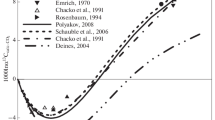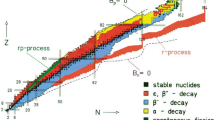Abstract
The 40K/40Ar method and its variant, 40Ar/39Ar, are based on the natural radioactive decay of 40K, one of the isotopes of potassium, in 40Ar, one of the isotopes of argon. 40K decreases in 40Ar* (the * symbol indicates that this is a radiogenic isotope) with a period of 1.25 × 109 years, according to the law of radioactive decay N = N0 e−λt. In other words, if we consider a closed system, containing at an initial time (t0) N0 atoms of 40K, then N0/2 atoms of 40K will remain in the system after 1.25 × 109 years. This gives us an indication of the geochronological application. If, in a geological sample, both the number of parent atoms remaining (40K) and the number of daughter atoms formed (40Ar*) can be measured, then it is possible to calculate the age of formation of this sample.
Access this chapter
Tax calculation will be finalised at checkout
Purchases are for personal use only
Similar content being viewed by others
References
Berger, G. W., & York, D. (1981). Geothermometry from 40Ar/39Ar dating experiments. Geochimica et Cosmochimica Acta, 45, 795–811.
Cassignol, C., Cornette, Y., David, B., & Gillot, P. Y. (1978). Technologie potassium-argon. C.E.N., Saclay, Rapport CEA R-4802, 37 p.
Cassignol, C., & Gillot, P.-Y. (1982). Range and effectiveness of unspiked potassium-argon dating: Experimental groundwork and examples. In G. S. Odin (Ed.), Numerical dating in stratigraphy (pp. 159–179). Chichester: Wiley.
Charbit, S., Guillou, H., & Turpin, L. (1998). Cross calibration of K-Ar standard minerals using an unspiked Ar measurement technique. Chemical Geology, 150, 147–159.
Dalrymple, G. B., Alexander, E. C. Lanphere, M., & Kraker, G. P. (1981). Irradiation of samples for 40Ar/39Ar dating using the geological survey TRIGA reactor. U.S. Geological Survey Professional Paper, 1176.
Dalrymple, G. B., & Lanphere, M. A. (1969). In J. Gilluly & A. O. Woodford (Eds.), Potassium-argon dating. Principles, techniques and applications to geochronology (251 p.). San Francisco, CA: W. H. Freeman and Company.
Dalrymple, G. B., & Lanphere, M. A. (1974). 40Ar/39Ar age spectra of some undisturbed terrestrial samples. Geochimica et Cosmochimica Acta, 38, 715–738.
Deino, A. L., & Potts, R. (1992). Age-probability spectra for examination of single crystal 40Ar/39Ar dating results: Examples from Olorgesailie, Southern Kenya Rift. Quaternary International, 13(14), 47–53.
Flish, M. (1982). Potassium-argon analysis. In G. S. Odin (Ed.), Numerical dating in stratigraphy (pp. 151–158). New York: Wiley.
Fuhrmann, U., Lippolt, H., & Hess, C. J. (1987). HD-B1 biotite reference material for K-Ar Chronometry. Chemical Geology, 66, 41–51.
Garner, E. L., Murphy, T. J., Gramlich, J. W., Paulsen, P. J., & Barnes, I. L. (1975). Absolute isotopic abundance ratios and the atomic weight of a reference sample of potassium. Journal of Research of the National Bureau of Standards, 79A, 713–725.
Guillou, H., Singer, B. S., Laj, C., Kissel, C., Scaillet, S., & Jicha, B. R. (2004). On the age of the Laschamp geomagnetic excursion. Earth and Planetary Science Letters, 227(3–4), 331–343.
Jicha, B. R., Singer, B. S., & Sobol, P. (2016). Re-evaluation of the ages of 40Ar/39Ar sanidine standards and super-eruptions in the western US using a Noblesse multi-collector mass spectrometer. Chemical Geology, 431, 54–66.
Kuiper, K. F., Deino, A., Hilgen, F. J., Krijgsman, W., Renne, P. R., & Wijbrans, J. R. (2008). Synchronizing rock clocks of Earth history. Science, 320, 500–505.
Laj, C., Guillou, H., & Kissel, C. (2014). Dynamics of the earth magnetic field in the 10-75 kyr period comprising the Laschamp and Mono Lake excursions: New results from the French Chaîne des Puys in a global perspective. Earth and Planetary Science Letters, 387, 184–197.
Lanphere, M. A., & Dalrymple, G. B. (2000). First principles calibration of 38Ar Tracers. U.S. Geological Survey Professional Paper, 1621.
Lee, J. Y., Marti, K., Severinghaus, K., Kawamura, K., Yoo, H. S., Lee, J. B., et al. (2006). A redetermination of the isotopic abundances of atmospheric Ar. Geochimica Cosmochimica Acta, 70, 4507–4512.
McDougall, I., & Harrison, T. M. (1988). Geochronology and thermochronology by the 40Ar/39Ar method (p. 212). New York: Oxford University Press.
McDougall, I., & Roksandic, Z. (1974). Total fusion 40Ar/39Ar ages using HIFAR reactor. Geological Society of Australia, 21, 81–89.
Merrihue, C. (1965). Trace element determinations and potassium argon dating by mass spectroscopy of neutron irradiated samples. Transactions American Geophysical Union, 46, 125.
Merrihue, C., & Turner, G. (1966). Potassium-argon dating by activation with fast neutrons. Journal of Geophysical Research, 71, 2852–2857.
Min, K. W., Mundil, R., Renne, P. R., & Ludwig, K. R. (2000). A test for systematic errors in 40Ar/39Ar geochronology through comparison with U-Pb analysis of a 1.1 Ga rhyolite. Geochimica Cosmochimica Acta, 64, 73–98.
Mitchell, J. G. (1968). The Argon-40/Argon-39 dating in coesite-bearing and associated units of the Dora Maira Massif, Western Alps. European Journal of Mineralogy, 3, 239–262.
Nier, A. O. (1950). A redetermination of the relative abundances of the isotopes of carbon, nitrogen, oxygen, argon and potassium. Physical Review, 77, 789–793.
Niespolo, E. M., Rutte, D., Deino, A. L., & Renne, P. R. (2017). Intercalibration and age of the Alder Creek sanidine 40Ar/39Ar standard. Quaternary Geochronology, 39, 205–213.
Odin, G. S. (1982). Interlaboratory standards for dating purposes. In G. S. Odin (Ed.), Numerical dating in stratigraphy (pp. 123–158). New York: Wiley.
Pereira, A., Nomade, S., Bahain, J.-J., & Piperno, M. (2017). Datation par 40Ar/39Ar sur monocristaux de feldspaths potassiques: exemple d’application sur le site pléistocène moyen ancien de Notarchirico (Basilicate, Italie). Quaternaire, 28(2), 149–154.
Phillips, D., Matchan, E. L., Honda, M., & Kuiper, K. F. (2017). Astronomical calibration of 40Ar/39Ar reference minerals using high-precision, multi-collector (ARGUS VI) mass spectrometry. Geochimica Cosmochimica Acta, 196, 351–369.
Renne, P. R. (2000). In J. S. Noller, J. M. Sowers, & W. R. Lettis (Eds.), K-Ar and 40Ar/39Ar dating, in quaternary geochronology: Methods and applications. Washington, D.C.: American Geophysical Union. https://doi.org/10.1029/rf004p0077.
Renne, P. R., Mundil, R., Balco, G., Min, K., & Ludwig, K. R. (2010). Joint determination of 40 K decay constants and 40Ar∗/40K for the Fish Canyon sanidine standard and improved accuracy for 40Ar/39Ar geochronology. Geochemica et Cosmochimica Acta, 74, 5349–5367.
Roddick, J. C. (1983). High precision intercalibration of 40Ar-39Ar standards. Geochemical and Cosmochimical Acta, 47, 887–898.
Samson, S. D., & Alexander, E. C., Jr. (1987). Calibration of interlaboratory 40Ar-39Ar Dating Standard, MMhb-1. Chemical Geology, 66, 27–34.
Steiger, R. H., & Jäger, E. (1977). Subcommission on geochronology: Convention on the use of decay constants in geo- and cosmochronology. Earth and Planetary Science Letters, 5, 320–324.
Turner, G., Huneke, J. C., Podosek, F. A., & Wasserburg, G. J. (1971). 40Ar-39Ar ages and cosmic ray exposure rays of apollo 14 samples. Earth and Planetary Science Letters, 12, 19–35.
Turner, G., Miller, J. A., & Grasty, R. L. (1966). The thermal history of the bruderheim meteorite. Earth and Planetary Science Letters, 1, 155–157.
Wänke, H., & König, H. (1959). Eine neue Methode zür Kalium-Argon Alterbestimmung und ihre Anwendung auf Steinmeteorite. Zeitschrift für Naturforschung A, 14a, 860–866.
Author information
Authors and Affiliations
Corresponding author
Editor information
Editors and Affiliations
Rights and permissions
Copyright information
© 2021 Springer Nature Switzerland AG
About this chapter
Cite this chapter
Guillou, H., Nomade, S., Scao, V. (2021). The 40K/40Ar and 40Ar/39Ar Methods. In: Ramstein, G., Landais, A., Bouttes, N., Sepulchre, P., Govin, A. (eds) Paleoclimatology. Frontiers in Earth Sciences. Springer, Cham. https://doi.org/10.1007/978-3-030-24982-3_5
Download citation
DOI: https://doi.org/10.1007/978-3-030-24982-3_5
Published:
Publisher Name: Springer, Cham
Print ISBN: 978-3-030-24981-6
Online ISBN: 978-3-030-24982-3
eBook Packages: Earth and Environmental ScienceEarth and Environmental Science (R0)




